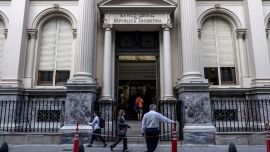For the third time in this series, the general trend to advance provincial polling (with three-quarters of the 24 districts voting locally before the October 27 general elections) dictates the original order being juggled – today Río Negro should be closing out both the Patagonian region and the 10 provinces with minimal Lower House representation (five seats), but it will have be postponed until next Saturday, on the eve of its April 7 provincial elections. As the next province according to this column’s criterion of ascending order of electorate magnitude, Argentina’s northernmost province of Jujuy, straddling the Tropic of Capricorn, thus jumps the queue.
Last week’s province, Formosa, was highlighted as the last of the quintet always governed by Peronism since 1983 but Jujuy was a member of that club right through to the last elections in 2015 – famously, when then-president Carlos Menem was being routed nationwide by the infant Alliance in the 1997 midterms by a 10-plus-percent margin, his denialism took the form of clinging to a runaway Peronist lead in the Jujuy township of Perico. But when Jujuy did finally change course in 2015, it did so with a vengeance – a 58.3 percent landslide for current Radical Governor Gerardo Morales as against 35.8 percent for the then-incumbent four-term Peronist governor Eduardo Fellner (with stints as Lower House speaker and Justicialist Party chairman also to his name). Just to place this landslide in its 2015 perspective, the backlash against 12 years of Kirchnerism gave Mauricio Macri’s Radical allies high hopes of grabbing several provinces in the often agricultural hinterland all the way down from Jujuy to Santa Cruz (but no joy apart from this dramatic exception of Jujuy’s seismic shift).
Other than Morales being a political Superman (of which he shows little sign), it would seem that only a miracle could explain this result. And a miracle there was indeed: Milagro Sala. That pugnacious indigenous social activist has certainly placed Jujuy on the world map, especially since being jailed early in 2016 within the first month of Morales. In the eyes of her admirers both at home and abroad, Milagro Sala and her Túpac Amaru organisation have pioneered indigenous empowerment with more housing starts than either the national or provincial programmes, for example, and today she is seen as a victim of political persecution. There is something in all of this (even if often achieved with Molly Maguire methods, which were deeply questioned by previous generations of Jujuy social activists such as Carlos ‘Perro’ Santillán) but quite apart from the embezzlement and other charges facing her, the Milagro Sala fan club needs to explain that 2015 result – it has no possible explanation other than that the mainstream of Jujuy society rejects the social leader, rightly or wrongly. At best a prophet not welcome in her own country.
So was 2015 a one-off or will Morales continue beyond the June 9 provincial elections? He would seem to have more than his fair share of the luck, which all successful politicians need at least as much as talent, because while he no longer enjoys the benefits of local fatigue with 32 years of Peronist (mis)rule and Túpac Amaru disruption more recently, he now has lithium. Thanks to that “white gold” (and also the Chinese-funded Cauchari, Latin America’s largest solar energy plant now only weeks away from completion), the Jujuy economy grew last year at around the same rate as the national economy shrank (2.5 percent) – second only to Neuquén with Vaca Muerta shale. On that basis the odds should favour Neuquén’s March 10 re-election being repeated here although if this year’s already dire economic data worsens nationwide, not even a candidate boasting 58 percent in the last election is safe. The Peronist rival of Morales still awaits definition but it might well be his own brother-in-law (quasi) – Senator Guillermo Snopek, whose sister Tulia is the governor’s significant other while awaiting divorce. The Snopeks are a traditional Peronist dynasty – a Snopek has been elected three times to govern the province since 1973 with even longer spells in the Senate.
Jujuy’s other voting need not detain us long – its three Senate seats (occupied by Snopek along with Mario Fiad and Silvia Giacoppo for Cambiemos) are not up until the next general elections in 2023 although the evenly divided six Lower House seats (Radicals María Gabriela Burgos and Silvia Martínez along with Osmar Monaldi from Macri’s PRO within Cambiemos versus Peronists José Luis Martiarena, María Carolina Moises and Alejandro Snopek – that surname yet again, while José Humberto Martiarena was a previous Peronist governor ousted by the 1966 coup) can never be an equal split with three seats up in each election (Martínez, Moises and Snopek are the seats falling vacant this October with chances of a Cambiemos gain).
Jujuy has a historic claim to uniqueness in being the only Argentine province not belonging to either the original 13 United Provinces of the River Plate in 1810 or to the clusters of northern and Patagonian territories promoted in 1955 – it formally separated from Salta in 1834 (the first governor, Colonel José María Fascio, had been a Spanish royalist commander in the wars of independence). Although long inhabited by various indigenous tribes (including the Jujuys) even before Inca, Quechua and Aymara penetration in the 15th century, Jujuy as such has no real pre-1834 history other than as a no man’s land between High Peru (today Bolivia) to the north and Salta and Tucumán to the south. Space is lacking here for local pre-1983 history although not bereft of interest with disputes on all frontiers (including Salta) and a major indigenous uprising in 1876. Of the 106 governors or trustees since 1834, it is worth highlighting Horacio Guzmán (who was both), whose strong provincial party the neo-Radical Jujuy Popular Movement helped to ensure Peronist dominance in the 20th century by splitting the opposition.
Jujuy’s population was estimated at around 730,000 in 2015 with 312,000 in or around the provincial capital of San Salvador – founded in 1593 and attractive enough with its colonial architecture and orange trees although Humahuaca (halfway up the road to Bolivia) is the real tourist jewel with its rich indigenous culture and spectacular canyon. San Pedro (60,666 inhabitants in the 2010 census) and Perico (49,125) are the next-biggest towns, both in the south, while the Bolivian border town of La Quiaca is also important.
The economy has always been primarily primary (mining with some oil and gas as well as agriculture) but today lithium and solar energy point to a whole new ball game, not to mention the new marijuana plantations for medicinal cannabis – run by the governor’s son Gastón Morales.
#10 Jujuy
Electorate (2017): 537,729
Governor: Gerardo Morales (Radical/Cambiemos)
Senators: Three (2 Cambiemos, 1 Peronist)
Deputies: Six (3 Cambiemos including 2 Radicals, 3 Peronists)
On the ballot: Three of six deputies























Comments